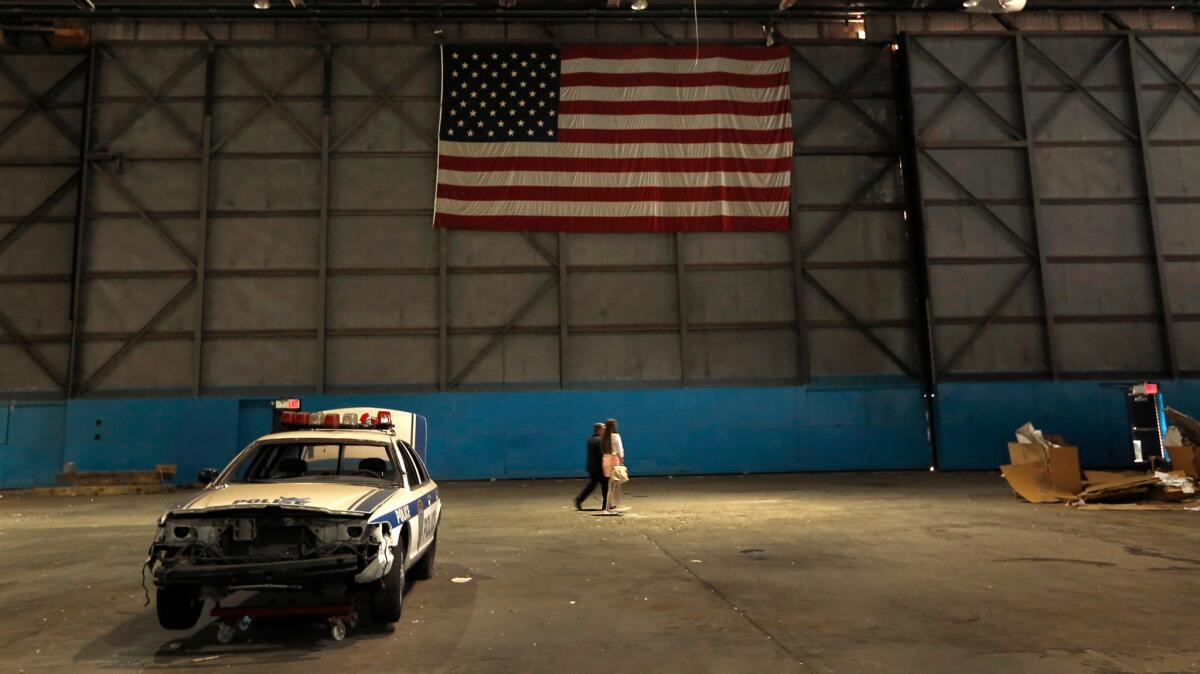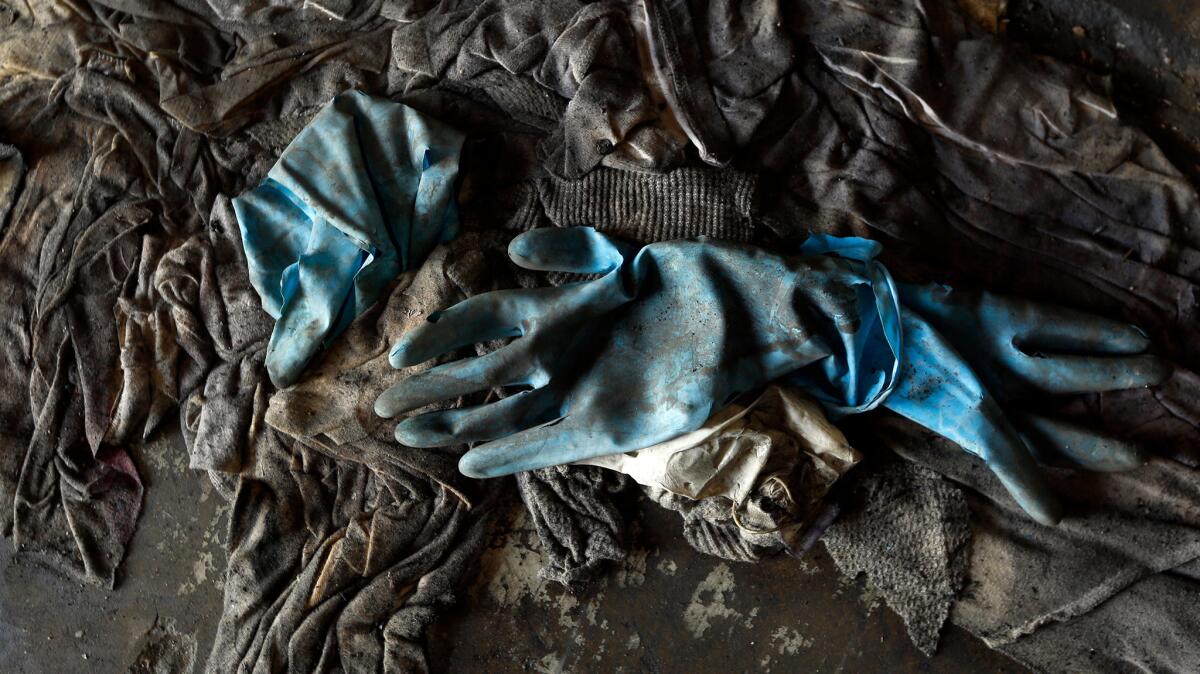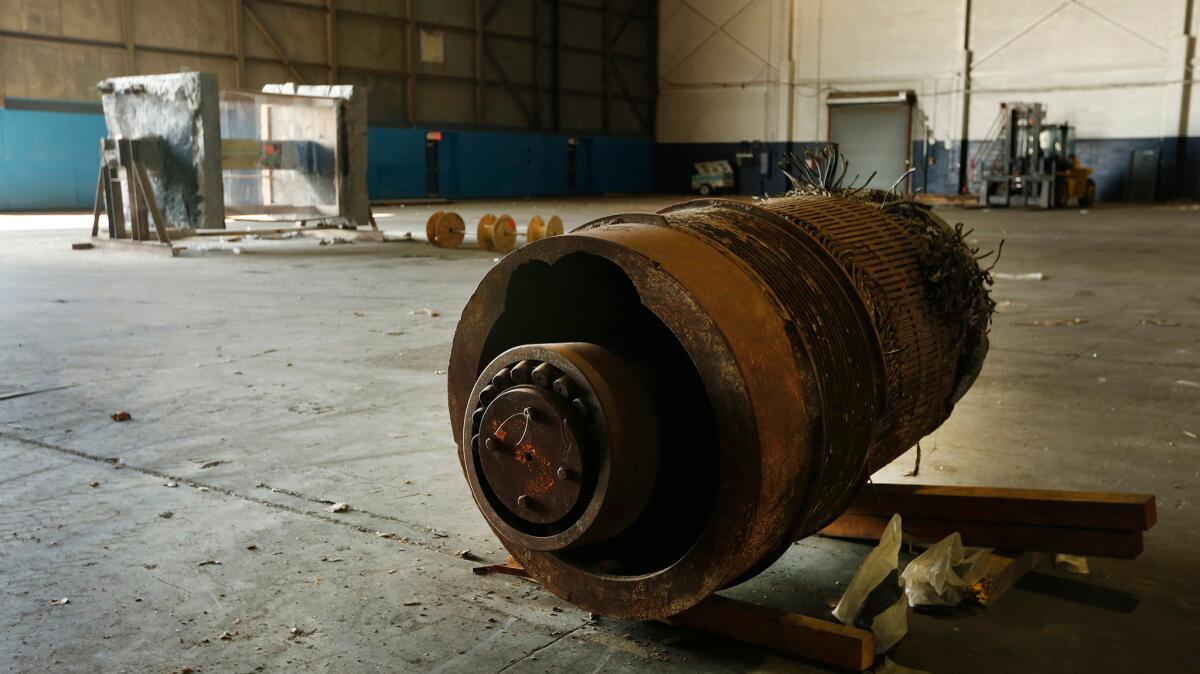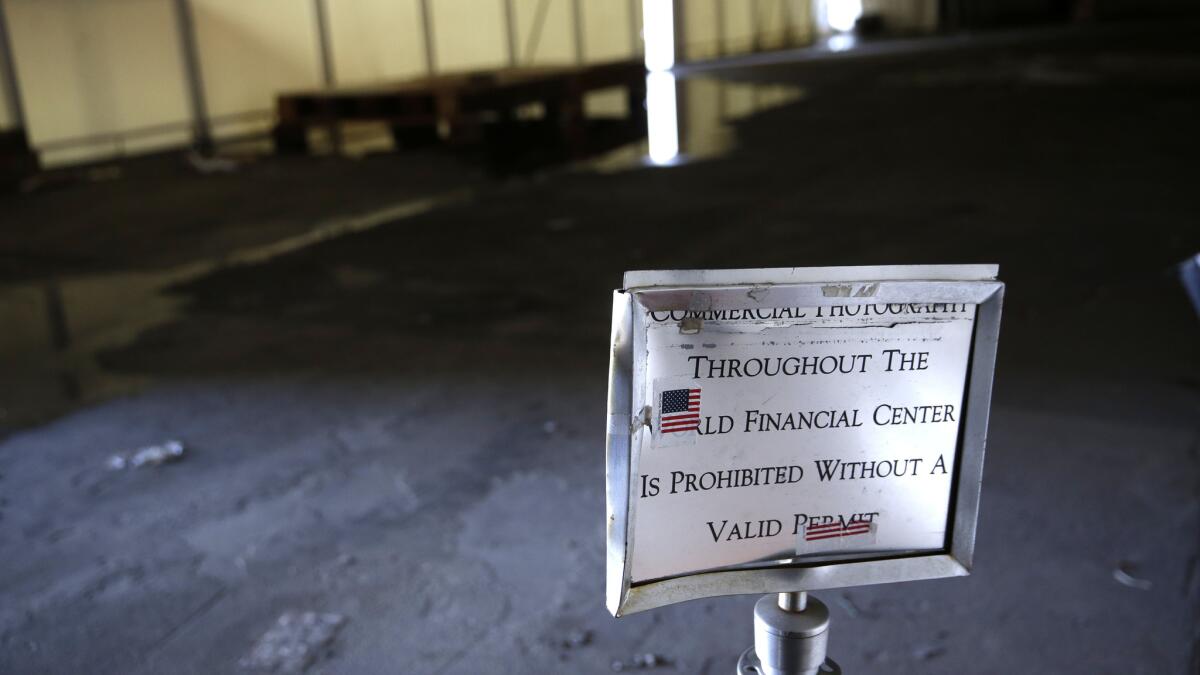A hangar at JFK became the tomb of 9/11. Now nearly empty, its job is done

- Share via
Reporting from New York City — A musty smell hangs in the air as pigeons swoop from the rafters and rainwater pools near a door. In the dim light, a battered Port Authority police cruiser sits abandoned – its twisted trunk popped open, the windshield gone and the front end bashed in.
Since the terror attacks of Sept. 11, 2001, the relics of the World Trade Center – shafts of broken metal, warped elevator doors, a crushed taxicab – have been entombed here in Hangar 17 at John F. Kennedy International Airport. But its somber purpose, as a way station for remembrances of 9/11, is ending. The final few pieces of that September morning are being carted out of the cavernous structure.
Soon Hangar 17 will be empty, its mission complete.
See the most-read stories this hour >>
The large, significant items – such as the huge steel tridents from the façade of the North Tower and the damaged firetrucks and ambulances that roared to the scene only to be crushed after they arrived – have been placed in the National September 11 Memorial & Museum in Lower Manhattan and in the state museums of New York and New Jersey, said Steve Coleman, a spokesman for the Port Authority of New York and New Jersey that owns the World Trade Center site.
The rest has been parceled out to towns across the country, U.S. military bases and embassies and foreign nations where they are required to be publicly displayed as part of smaller 9/11 memorials.

The numbers are staggering. Some 2,500 items have been distributed to about 1,440 municipalities, schools, fire departments, nonprofits and other groups and foundations, said Amy Passiak, the archivist who has been supervising the dissemination project since 2010.
“It’s been a very humbling experience,” Passiak said as she walked through the hangar on a recent morning. “I have met people from every aspect and association of this event – survivors, family members (of victims), emergency personnel, recovery personnel from all over the country, representatives of other countries whose civilians were killed.”
One of the few relics still awaiting placement is a jumble of twisted steel, metal mesh and concrete, a blob of debris that looks as if it’s part salvage yard junk and part modern sculpture. It is, in fact, material from what came to be called “the pile,” the ton upon ton of crushed remains from the collapsed towers.
For Passiak and officials of the Port Authority, the goal of distributing these relics – even to places that might not have a direct connection to the terrorist attack – has been to keep alive the memory of 9/11.

“Because it was such a unifying event, I think that a lot of smaller towns, emergency services and schools really want to create a continuing knowledge about what happened and find a way of connecting it to U.S. history,” Passiak said.
On this day, Passiak was preparing for two rusted train tracks recovered from the commuter rail line underneath the trade center to be picked up by “the Iowans,” as she called her expected guests. Just before 11 a.m., a white Chevy pickup truck pulled into a lot next to the hangar as a jet lifted off from a nearby runway and rumbled overhead.
Out of the truck stepped Elaine and Tom Howard, a retired couple from Hamburg, Iowa, who had arranged through a community booster organization, Hometown Pride, to secure the tracks for a memorial in their town’s Heroes Park.
See more of our top stories on Facebook >>
They had driven the nearly 1,300 miles to New York City to personally deliver the train tracks back to Hamburg and its 1,187 residents. “What better place to have a little piece of the World Trade Center than Heroes Park,” said Elaine Howard, 67.
The tracks were not so little. Each section, about 10 feet long, weighed approximately 600 pounds. The Howards’ faces fell when a Port Authority worker who had transported the tracks to their vehicle on a forklift expressed doubt that they would fit into the truck’s bed.
The tracks did, in the end, fit, although a slightly longer one jutted out a bit. They were secured with heavy chains for the drive home.

The fact that the hangar is now nearly empty is gratifying to Amory Houghton, a former Port Authority executive who first oversaw Hangar 17, beginning in 2002, when it was filled to the brim with steel beams, damaged emergency vehicles and other debris brought from the World Trade Center site to save them for posterity.
“The goal all along has been to have some of this steel in as many places as it could possibly be,” said Houghton, who left the Port Authority in 2007.
He recalled bringing in preservationists and archivists to begin the daunting process of cataloging and protecting the relics. “We were part laboratory, part historical archive and part morgue,” he said.
Hearing that most of the World Trade Center objects now were placed elsewhere, Houghton said, “I’m really happy that this stuff has been spread out all over the place. … I think it just keeps it alive given the inevitability that the longer time passes the more memory fades.”
The Howards’ was one of the final pickups at Hangar 17, which the Port Authority expects to close later this summer when the last of the relics are cleared out. The gray-and-white structure, dating back to the 1960s when it was built for Pan Am Airways, probably will be razed, the space used for other airport purposes, possibly aircraft parking, Coleman said.

The three biggest pieces still left inside – concrete slabs from the parking garage, a mangled elevator motor and a section of the antenna (each estimated to weigh about 20 tons) – were to be picked up in the next few weeks by representatives of the Stephen Siller Tunnel to Towers Foundation of Staten Island, named after a firefighter killed on Sept. 11.
A set of steel beams was going to an engineers’ union in Queens. Still left were additional train tracks and the material from the pile, which Passiak said she hoped to place with organizations that had expressed interest in obtaining relics.
Also unclaimed was the lone Port Authority police car, dust from the World Trade Center debris still coating its blueandwhite paint.
“I think we’ll find a home for it, too,” Coleman said.
Haller is a special correspondent.
MORE NATIONAL NEWS
Orlando nightclub shooting: 50 killed, 53 injured; gunman identified as Omar Mateen
A look at the abortion case before the Supreme Court, by the numbers
Ex-’Voice’ contestant Christina Grimmie did not know the man who killed her, police say
More to Read
Sign up for Essential California
The most important California stories and recommendations in your inbox every morning.
You may occasionally receive promotional content from the Los Angeles Times.










